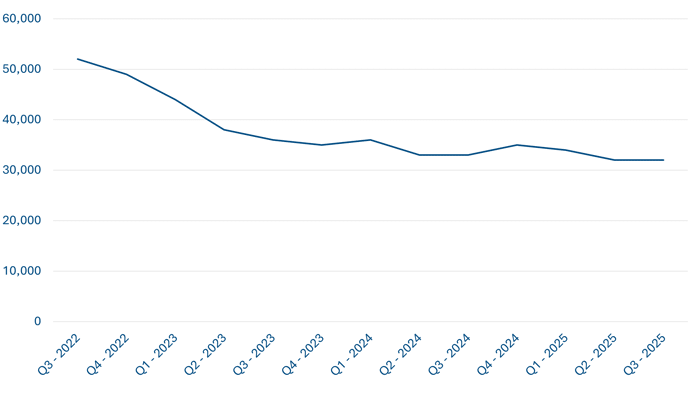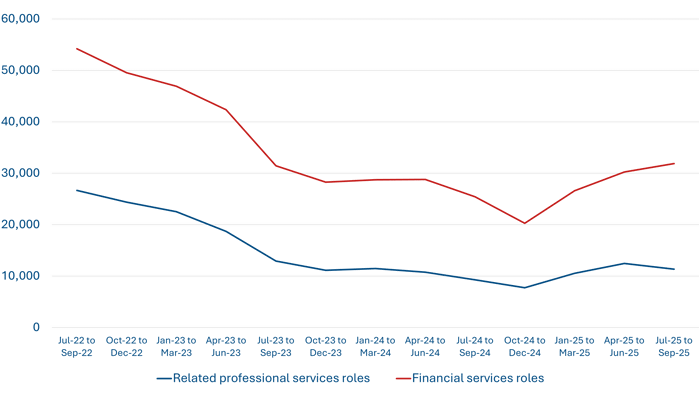We have updated our proxy dataset to analyse demand for some types of financial and related professional services jobs over time and by UK region
Jobs numbers and labour market trends are receiving considerable public, policymaker and media attention at the moment, and it’s been some time since I used this blog to analyse trends in financial services employment—so an update seemed very topical.
Official job vacancy data is based on a survey of businesses. Across the UK, the number of job vacancies in financial services averaged around 33,000 in the first three quarters of 2025, broadly unchanged from the year-earlier period.
Financial services job vacancies

Source: Office for National Statistics
Vacancies are not a perfect metric, as there are reasons a firm might advertise a role other than the need to fill that role. Nevertheless, they are an indication of labour demand. In particular, they are a good indicator of trends, when the data are examined over a period of time. Taking a longer view, over the past five years, demand for UK financial services employment (as measured by online job vacancies) rose sharply over 2020-2022, peaking at 56,000 in April-June 2022, and has declined steadily since then.
In this context, ‘financial services’ refers to a specific classification of companies based on their type of economic activity (Standard Industrial Classification). ‘Financial services’ job vacancies therefore comprise all job vacancies in finance, insurance and an ‘other’ category called ‘activities auxiliary to financial services and insurance activities’. These vacancies could be for what we would tend to think of as a finance job—for example, an equity research analyst or an insurance broker. But they could also be for a non-finance specific job in a financial services company—for example, a software engineer or a data analyst. The data therefore tell us something about demand for labour among financial services firms, but nothing—necessarily—about demand for particular roles within the industry.
To examine this, we have used “official statistics in development”[1] from the ONS to focus on roles that are within the financial and related professional services industry, and unlikely to be in any other industry. These are:
|
Financial services roles |
Related professional services roles |
|
Finance and investment analysts and advisers |
Barristers and judges |
|
Brokers |
Management consultants and business analysts |
|
Insurance underwriters |
|
|
Bank and post office clerks |
|
|
Pensions and insurance clerks and assistants |
|
The ONS published data using Textkernel online job adverts data.[2] They show volumes of online job adverts by different geographies for these and 406 other occupations.
Online job adverts for selected financial services and related professional services roles

Source: TheCityUK calculations based on ONS data from Textkernel.
The data show that for the seven roles that we can confidently say are in the financial and related professional services industry (five in financial services and two in related professional services), online job advertisements declined sharply and steadily from 2022 until the last quarter of 2024. At that point, there was a modest recovery which was sustained over the subsequent three quarters—the latest data available is for Q3 2025.
In the July-September 2025 quarter there were 31,884 online job advertisements for the financial services roles, up from 25,425 a year earlier but down from a peak of 54,201 in the post-pandemic hiring boom in January-March 2022. For the two related professional services roles, online advertisements totalled 11,347 in the latest quarter, up from 9,299 a year earlier and a peak of 31,220 in January-March 2022.
Our analysis at a regional level showed no significant variations in this trend in any particular region. Use the filters in the chart below to view the data by region.


